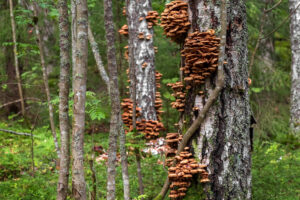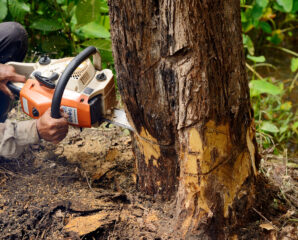Bonaire, Georgia, is home to many Houston County residents and many, many trees. If you’re a homeowner or property manager in the area, chances are your yard or property features a variety of native pines, oaks, dogwoods, or other tree species that create beautiful views, enjoyable shade, and living spaces for hundreds of creatures and critters.
While your trees offer plenty of functional and aesthetic benefits to your property, it’s important to know when to say goodbye to the ones needing removal.
Tree removal is essential to home or property ownership as it helps protect your house, cars, family, yard, and surrounding neighbors from dangerous or problematic trees. While there are obvious signs that a tree should be removed – dead branches, too much leaning, and trunk decay, for instance – it can be difficult to recognize other signs of danger.
To spot a problem tree before a disaster occurs, take a look at these three warning signs indicating it’s time for tree removal:
Mushrooms Are Growing on the Tree Trunk

Mushroom growth on tree bark is not normal and only occurs when a tree is rotting. If you notice mushroom or fungal growth on the trunk of your trees, it is likely a sign of heart rot.
Heart Rot
Heart rot is the development of a fungal disease that causes the tree to decay from the inside out. The process begins when fungi work their way into a tree through trunk damage, or wounds, and eat away at the tree’s center.
Tree wounds can occur due to:
- Branch breakage
- Damage caused by insects, animals, or humans
- Fire damage
- Poor pruning methods
As the fungi take over, the tree’s core softens, causing the tree to lose strength and stability. Heart rot can take decades to devour a tree from the inside out completely, but even a few years of tree rot can weaken a tree enough for it to topple over in a storm or come crashing down when exposed to other environmental factors.
If and when the fungal growth works its way out to the exterior side of the tree, mushrooms will begin to grow on the trunk, telling you that it is time to remove the tree while it is still standing.
There Are Burrow Holes in the Tree Trunk
Tiny burrow holes that go deep into your tree trunk are signs of an infestation of tree-killing insects. The damage-causing insects most common in Georgia include:
- Pine bark beetles
- Emerald ash borers
- Bark beetles
- Pine weevils
These insects feed on the components of the tree, such as its bark, living wood, and sap, and dig their way into the tree to get the most out of it. With enough holes, the tree loses its structural integrity and becomes vulnerable to falling or bending during strong winds or storms. If an infestation carries on long enough, the tree can topple over, no severe weather required.
If you have a tree with many burrow holes on the trunk, consider removing it to avoid future disasters, and talk to an exterminator about pest management to prevent further infestation.
There Are Deep Vertical Cracks on the Tree Trunk
Vertical cracks on the tree trunk do not always indicate that your tree is unhealthy, especially if the cracks only affect the bark. While cracks on the bark are not ideal, your tree can heal and recover. However, when the cracks expose the tree’s interior, the likelihood of fungi infecting and weakening your tree increases significantly.
Some causes for tree cracks can include:
- Sunscald – Cracks can develop when there is too much sun exposure on a tree.
- Frost cracking – Cracks can develop when water in a tree freezes and expands.
- Irrigation-related growth – Cracks can develop when a tree receives too much water and experiences a sudden growth spurt.
- Poorly timed fertilization – Cracks can develop when a tree is fertilized too late into the season, causing it to grow instead of becoming dormant for the colder months as it should.
If you have a tree with deep cracks along the trunk, check for additional signs of rot or decay and talk to a tree specialist to determine if removal is necessary or if recovery is possible.
When you need tree removal at your home or property in Bonaire, Georgia, call Montpelier Tree Service.
Our tree removal experts and arborists have served homeowners and property owners in Bonaire, Warner Robins, and Houston County since 2000. It’s our mission to protect your property by helping maintain your healthy trees and removing dangerous dead or dying ones. Talk to us about your tree needs today! 478-721-8833
Montpelier Tree Service is a full-service arbor company in Central Georgia:
- Blairsville
- Bonaire
- Byron
- Forsyth
- Fort Valley
- Gray
- Jackson
- Kathleen
- Macon
- McDonough
- Peach County
- Perry
- Roberta
- Warner Robins
 Montpelier Tree Service
Montpelier Tree Service 